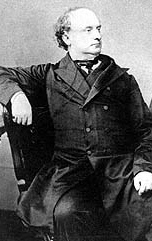
An early resident of a house I have just researched in Kensington was Ernest Jones, one of the most prominent figures in the Chartist movement in the 1840s and 1850s. His speeches, in which he openly advocated physical force, led to his prosecution, and he was sentenced in 1848 to two years' imprisonment for seditious speeches. While in prison he wrote, it is said in his own blood on leaves torn from a prayer book, The Revolt of Hindostan, an epic poem.
Upon his release from prison he became a leading figure in the National Charter Association and helped to give the Chartist movement a clearer socialist direction. He knew Karl Marx and Friedrich Engels personally. Marx and Engels at the same time commented on the Chartist movement and Jones' work in their letters and articles.
He is believed to have sacrificed a considerable fortune rather than abandon his Chartist principles.
A further fact about Ernest Jones is that he didn't always pay his fishmonger - this was extremely lucky as it happens and was the only clue to his identity when I was researching his Kensington home. Entries in the rate books and directories of an 'Ernest Jones' provided little guidance and the family was unluckily away at the time of the census. It was only when I chanced upon an article in the press about an argument between Jones and his fishmonger that everything fell into place. This is why house historians are often called 'house detectives'!
